Breathing New Life Into Humanities At Rose State College
Hi readers and writerly friends!
This week in Artsy Things, I wanted to republish an article I wrote for the 6420 Magazine. They’ve redone their website again so I figured I’d try and post all my writing here! This article was supposed to be second in a three part series, but was adjusted to fit all the core information into one brief article for the magazine. You can learn more from the articles linked at the end of this blog post!
In part one of this series, we looked at the research and development the Fall 2019 Mural class conducted in preparation of the new humanities mural. They visited with Randy Marks from OKC’s Office of Arts and Cultural Affairs, Pablo Barrera from Oklahoma Contemporary, and the heads of the Arts Division from OCU to see what the process was like getting a mural up in public spaces, what Oklahoma Contemporary was doing to make public art more accessible, and what new courses and features OCU’s art division had to offer art majors transferring from Rose State College.
The start of an art-covered campus at Rose State
Even though the process for getting a mural up at Rose State was different than the process for public art, they still had to render out their ideas, budget their supplies, and put together a presentation for the Humanities Building Interior Mural Committee on the Rose State College campus. They narrowed down their ideas down to two mural concepts, one done by Fine Arts major, Ashley Gilliland and one done by myself. The committee chose Ashley's design due to time constraints and planned for my mural to be done next semester.
Once all of the prep work was complete, the mural was set to begin. They started sketching the design out on the wall and in days, had the first layers of paint up. Over the past few months, they've been working on it, each Tuesday and Friday, and they made considerable progress for only working two days out of each week of the semester. They just finished the mural and sealed it on Tuesday, December 10th, 2019, so it's officially finished.
Suzanne Thomas described her thoughts on the mural class, how it differed from previous years’ classes, and her thoughts on the mural:
“This mural class was more about the process and procedures that an artist must go through before they create artwork. Especially artwork that is meant to be viewed in public. I think a lot of art students have this idea that art is just about their personal expression, but public art, i.e., like murals, are about the reflecting the values within the community at large. This class was different in that there was more research that had to be done, more collaboration among the students, and Humanities faculty. I am really proud of the mural and their work!” said Thomas.
No Limitations


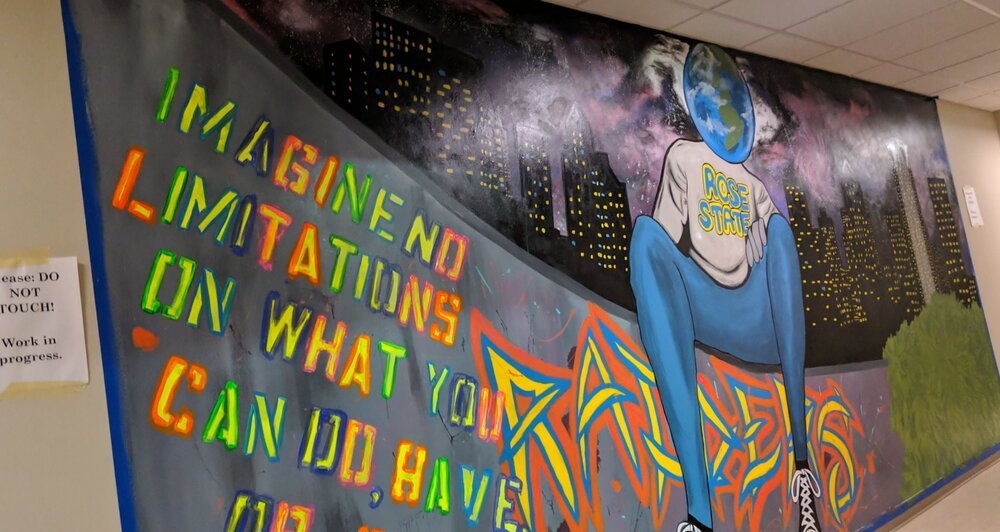


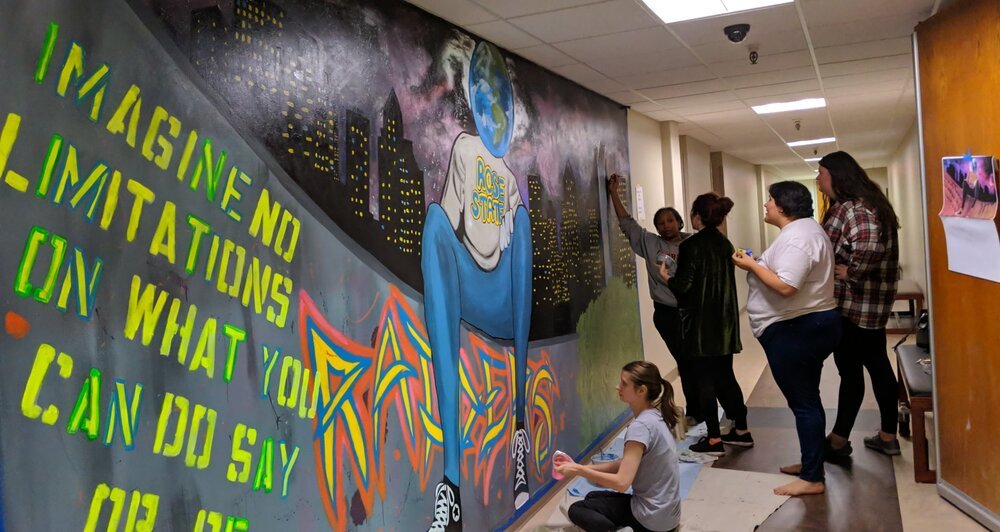









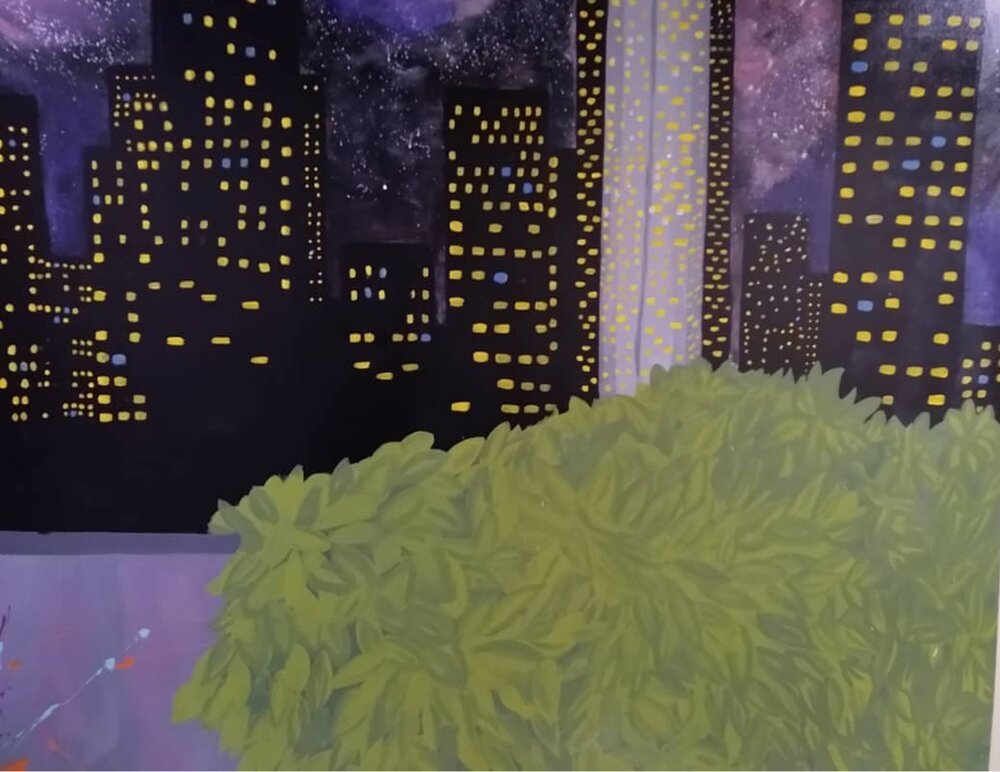

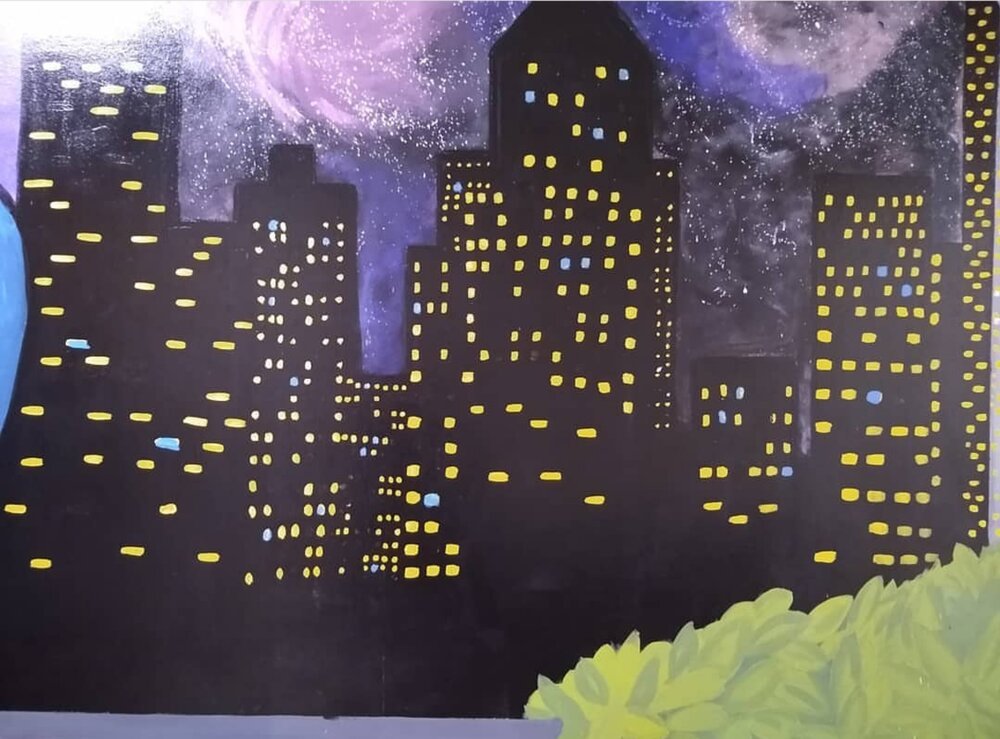

No Limitations mural in the Humanities building at Rose State College
Humanities Brain Mural Planned for Spring Semester
When the mural class rendered out their concepts for the first painting, at least three of five students came up with a left brain versus right brain type of design. They said this happened with zero communication or collaboration on their part and thought it was a good sign that they were on the same page. However, due to the fall semester moving so quickly, the students of the mural class, Suzanne Thomas and the Humanities Building Interior Mural Committee agreed it made more sense to do Gilliland’s mural in the fall semester and save my mural for the spring semester.
The Humanities Building Interior Mural Committee was torn between the two mural concepts and voted to have both done since they couldn’t pick one over the other. The second design is planned for the spring semester. I will be completing the mural as an honors credit project for my painting class, with the help of volunteer high school students from Midwest City High School. We’re still getting all our ducks in a row but so far, Humanities Dean, Toni Castillo’s approval we have a few students who have volunteered to work on the mural, and Suzanne Thomas’ has agreed to mentor me on the project.
Since I will be spearheading the project, it is my job to organize all the logistics from reaching out to the high school to recruit students, obtaining liability waivers, and getting everything approved between both schools. This project is exciting because it benefits all three parties—the MCHS students who will be receiving recognition for their volunteer work on the project, Rose State College which is using this as a recruitment opportunity for the Fine Arts Department, and myself who will of course receive recognition for the concept as well as an opportunity to participate in a leadership program.
Toni Castillo, Dean of Humanities provided her thoughts on both of the murals and her plan for breathing new life into the Humanities building:
“The mural project is a perfect opportunity for the Humanities Division Art Program to showcase the exceptional talents of Rose State students. I am particularly gratified that the project is completely student driven—their vision, their presentation, their implementation—so that eventually that entire upstairs corridor of our building will be a legacy of their values left for all who come here. Professor Suzanne Thomas, who has headed the project, has shown particularly strong leadership in the way she has structured the class and worked with dedicated Honors Program students to complete the project, as those students have in turn reached out to involve area high school students. The project in that corridor will be ongoing for several years until we finally have a true venue for experiential art here at Rose.” said Castillo
Spring Humanities mural completed in the summer of 2020 due to COVID-19 Pandemic
Unfortunately due to the pandemic, I had to push my mural back until the summer where I was one of the only people allowed in the building. Since then, I have completed it and was awarded honor’s credit for it’s completion. It was an incredible opportunity I will be gracious to Rose State College and Suzanne Thomas for forever. Below is a slideshow of the completed mural.
Humanities
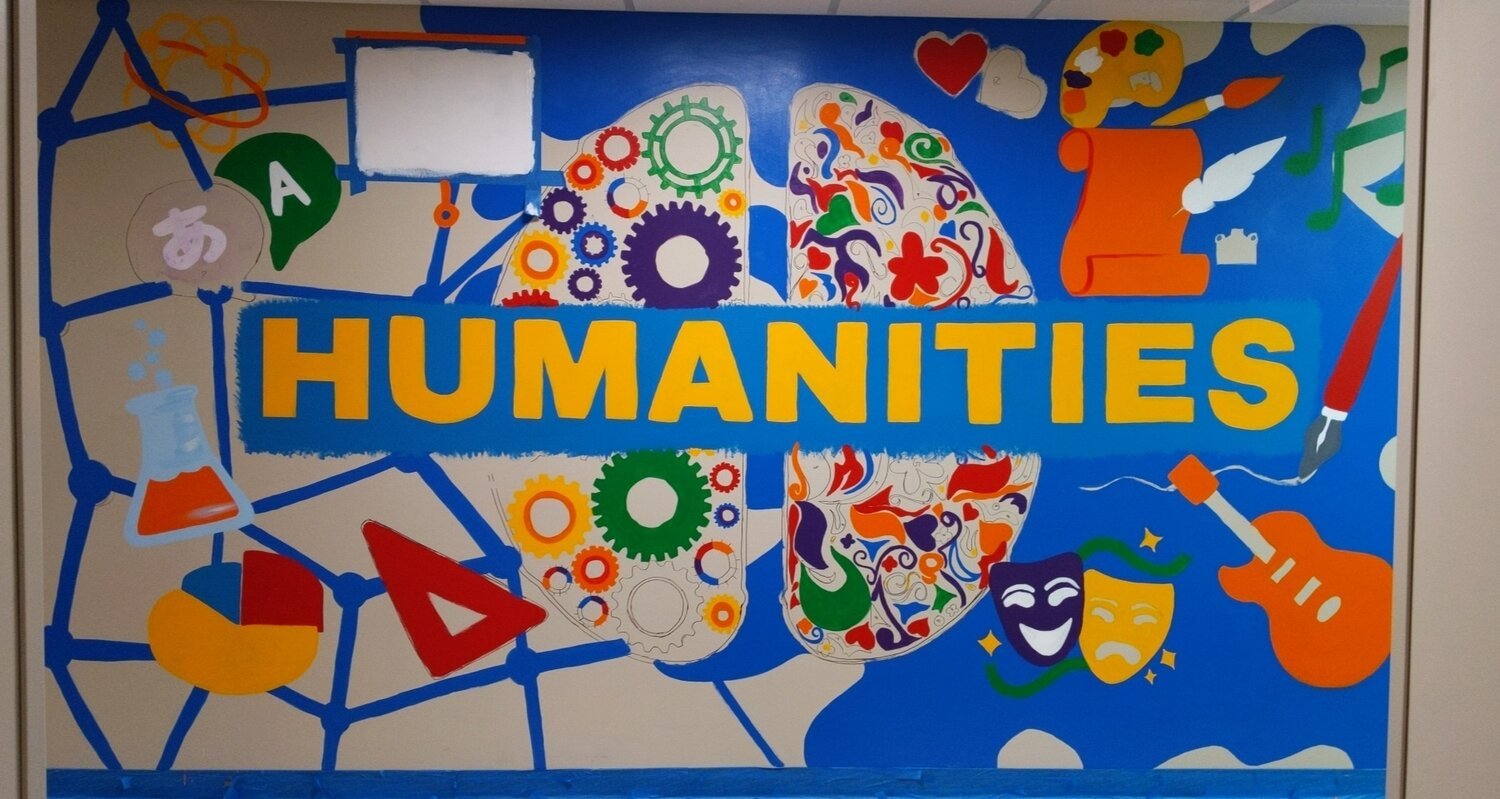
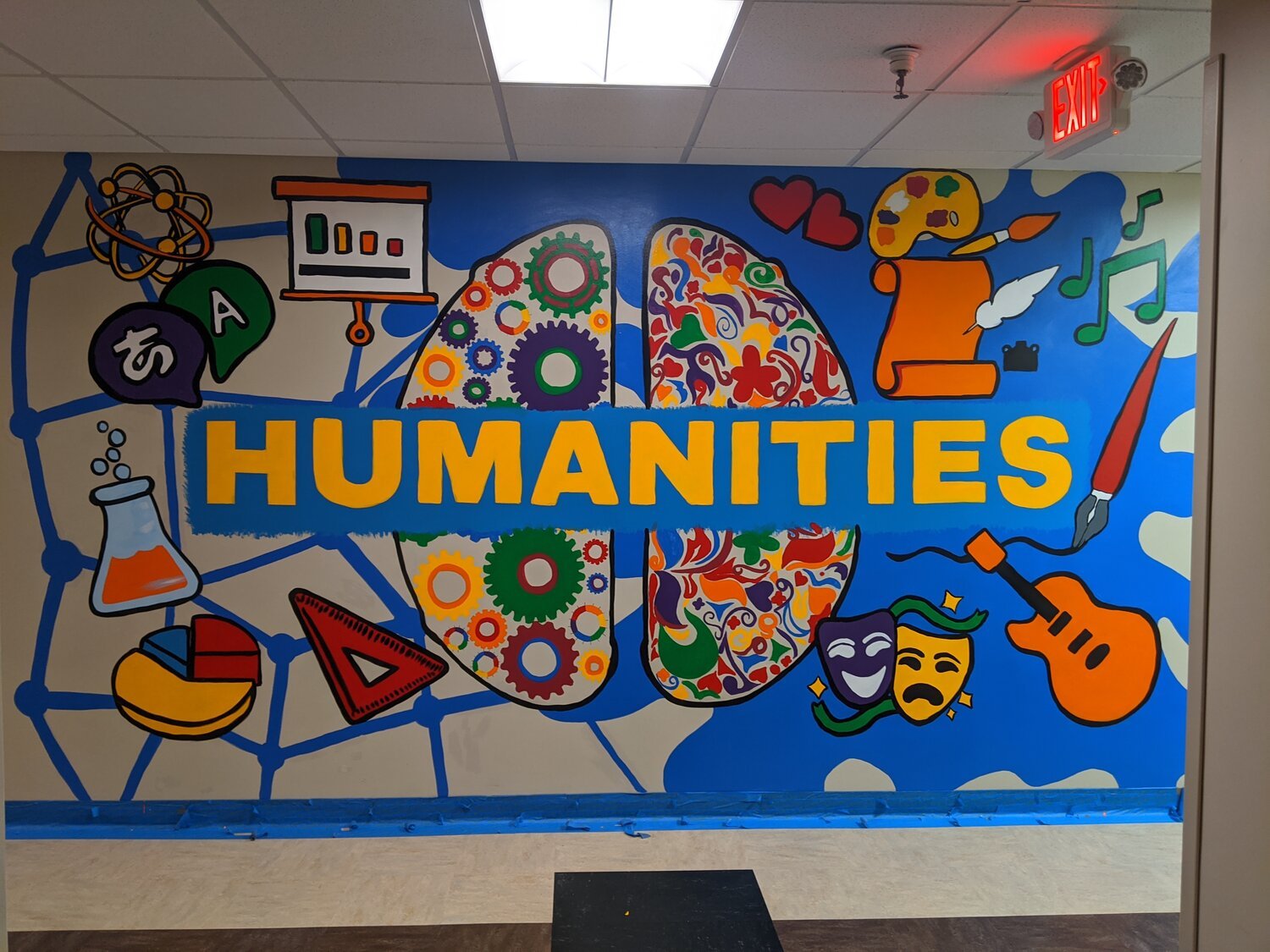
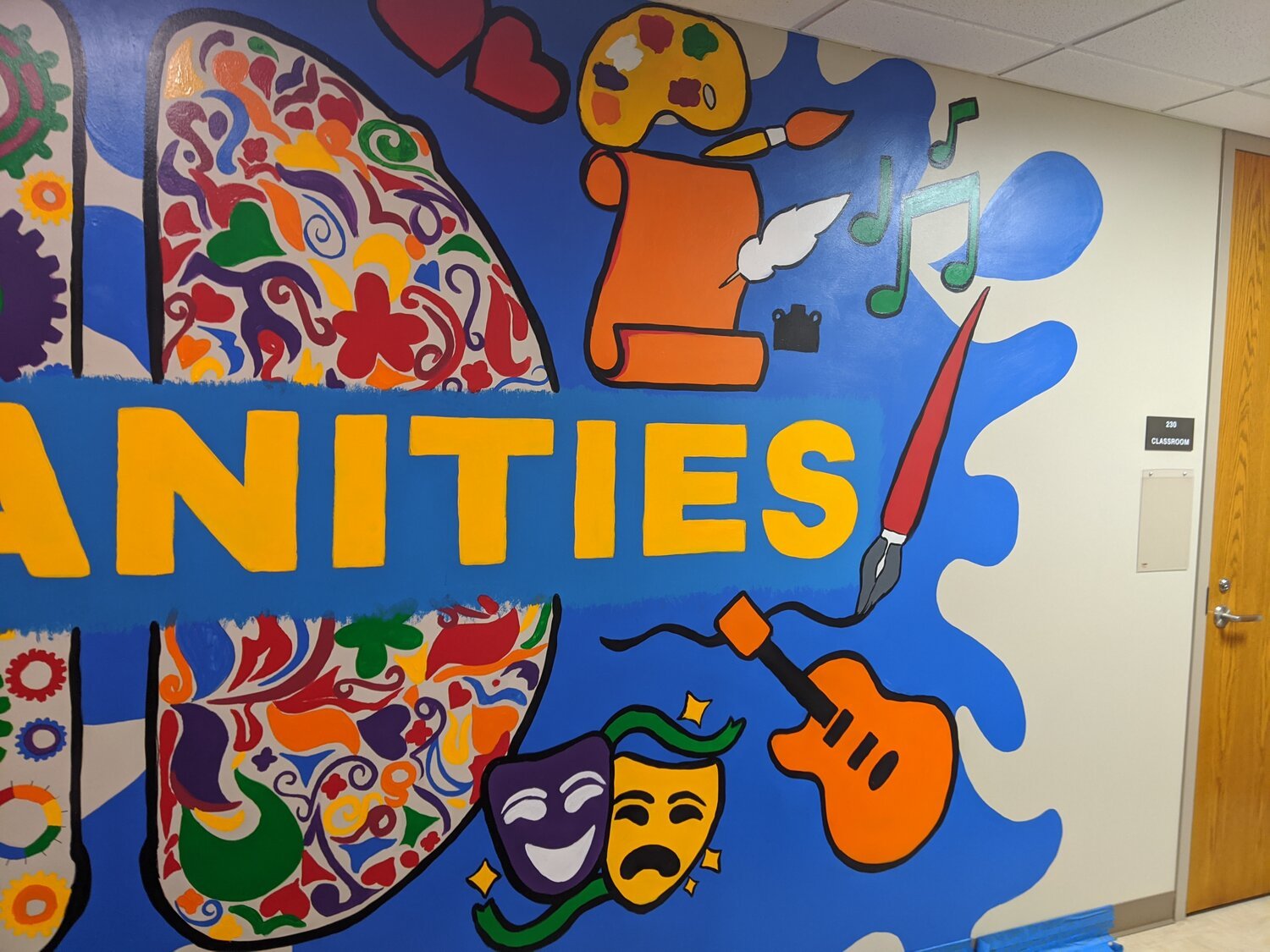

“Humanities” mural in the upstairs back hallway of the Humanities building at Rose State College
Further reading
Exploring Oklahoma Murals Where Public Art Is More Than Paint
Exploring Oklahoma Murals Where Public Art Is More Than Paint
Is there an official opening date? Will there be a special opening ceremony or event for the public?
Oklahoma Contemporary - New Home
Artist VARA Waiver
General VARA Waiver for Works of Visual Art
COVID-19 Delays Oklahoma Contemporary’s New Location Opening Ceremony
New Light—Oklahoma Contemporary’s Plan to Re-Open
Making Space With Oklahoma Contemporary Interview With Pablo Barrera
Making Space With Oklahoma Contemporary: Interview With Pablo Barrera
Thank you for reading my article about murals at Rose State College and fine arts in the OKC area! If you’re in the area and interested in art, I highly encourage you to check out Oklahoma Contemporary and get involved with the art community here in Oklahoma!
—Payton
Exploring Murals In Oklahoma: Where Public Art Is More Than Just Paint
Public art, particularly murals, plays a significant role in enhancing urban spaces and fostering community identity. In Oklahoma, the process of creating murals involves collaboration between artists, city officials, and property owners. Legal considerations, including the Visual Artists Rights Act (VARA), protect artists’ rights and ensure their work is respected. Additionally, partnerships with local organizations and educational institutions provide opportunities for aspiring artists to gain experience. This dynamic environment encourages artistic expression while promoting cultural appreciation.
A photo of the students from the Fall 2019 Special Topics In Art: Murals class paint the finishing touches on a mural. This mural is set to be the first of a series of murals as part of the ongoing project, “Breathing New Life Into The Humanities.” This project is expected to continue into 2025 and draw nearer to completion with each following Special Topics In Art: Murals class taught by Suzanne Thomas. Photo by Ken Beachler.
Hello readers and writerly friends!
If you’re a returning reader, welcome back and if you’re new to the blog, thanks for stopping by! In this blog post I’ll be doing an in-depth article discussing the murals and public art scene in Oklahoma. This article was originally written for The 6420 Magazine at Rose State College in 2020 and is the first part of a three-part series spanning a range of topics to do with Oklahoma’s public art stage. You can find the next two articles in the series linked in the “Related Topics” section towards the end of this post.
In Suzanne Thomas’s Fall 2019 Course, Special Topics In Art: Murals, students learned all the ins and outs of getting a mural up in public space when they met with the Randy Marks from the Oklahoma City Office of Arts and Cultural Affairs. The same day, they met with Pablo Barrera, Oklahoma Contemporary’s inaugural Curatorial fellow and the Division heads of the Fine Studio Arts at Oklahoma City University. After learning about the public art process and different opportunities for art in Oklahoma, the students began preparing for the mural they’d be painting in the upstairs, back hallway of the Rose State College Humanities building.
Insights On Artists’ Rights and How To Get Murals Approved In Oklahoma City, From The Office of Arts and Cultural Affairs
Putting up a mural in public spaces or on private property doesn’t just consist of slapping some paint up on a wall—at least not in the beginning. Since the canvas is often property of the city as well as private owners, there’s several steps an artist must take before ever picking up their paintbrush.
When the mural class met with Randy Marks from the Oklahoma City Office of Arts and Cultural Affairs, they learned that the process for getting not only murals, but other forms of public art installed is a much more extensive process than slapping paint up on a wall. First, one must go through Oklahoma City’s Office of Arts and Cultural Affairs to get their artwork approved, if it’s going to be on public property or on the external surface of a building. Indoor murals are at the discretion of the property owner.
The mural artist must build a presentation which includes the stages of execution, mockups, expected start and finish date, location, and a budget for the project if it will require public funding from the city. The presentation must be formally presented in front of the Oklahoma City Office of Arts and Cultural Affairs Committee and approved. Once approved, the artist will begin preparing for the mural process; this includes gathering materials, preparing the workspace, and getting the necessary paperwork and waivers in order.
The next step in the process is the VARA Rights Waiver and muralists as well as sculptors and other visual artists must have one. The Visual Artists Rights Act (VARA), which allows artists to prevent certain actions regarding their artwork, was enacted in 1990. This act protects visual artists' moral rights by prohibiting the distortion, mutilation, modification, or destruction of their work in a way that could damage their reputation. Oklahoma City’s Office of Arts and Cultural Affairs recommends that property owners commissioning visual art for an interior/exterior space should ask the artist to sign a VARA Rights Waiver before the work has begun and have it reviewed by an attorney to ensure that the rights for the artwork are clear, legally binding, and transferrable to future owners of said property. Conversely, muralists and other visual artists should be familiar with The Visual Artists Rights Act, the VARA Rights Waiver, and other applicable copyright and property laws that may affect their rights as artists creating public works of art.
When the mural class met with the Oklahoma City Office of Arts and Cultural Affairs, they learned the importance of VARA waivers. The need for VARA waivers was highlighted when a new company, Alotta Action Advertising, moved into the building on the southeast corner of Northwest 46th Street and Western Avenue and painted over world-renowned and beloved Oklahoma artist, Bob Palmer’s 2-year old mural. This mural was a legacy piece by one of Oklahoma’s most acclaimed artists, and the idea that it has been covered up has a lot of artists upset at the lack of respect for the internationally revered painter. After this poorly-received decision had district leaders, local artists, and OKC citizens alike seeing red, both literally and figuratively,
The mural class also learned about Kent Twitchell, the Los Angeles artist who settled his lawsuit against the U.S. government and 11 other defendants, for $1.1 million, for painting over his six-story mural—“Ed Ruscha Monument,” that was painted on the side of a federal government-owned downtown building.
Once all of this has been done and the artist gets the green light, work can commence on the project—and that’s when the paint finally goes up on the wall.
Making Space With Oklahoma Contemporary
After their meeting with Oklahoma City Office of Arts and Cultural Affairs, the class stopped by the newly constructed Oklahoma Contemporary building to check out the building-in-progress the murals adoring the fences around the construction site, and to chat with Pablo Barrera, the Director of Oklahoma Contemporary. He told them Oklahoma Contemporary’s new building would be open in March 2020 (the opening has since been postponed due to the 2020 COVID-19 Pandemic), that the building’s exterior was made to reflect Oklahoma’s picturesque sunsets and sunrises. He also showed us the murals that they’ve set up along the construction site, called Making Space.
Visiting The Fine Studio Art Division at Oklahoma City University
When the students finished their visit with Pablo Barrerra at the Oklahoma Contemporary construction site, they visited briefly with Bryan Cardinale-Powell, Associate Professor and Chair of Visual Art and Film, and Jeff Price, Professor of Game Design and Animation at Oklahoma City University. They learned about their extensive art programs, saw their high-tech graphic design studio, and some of their projects for upcoming courses—notably their motion capture room which was under construction during the students’ visit. The class got the opportunity see an all-encompassing art studio with every tool one could imagine for bringing artwork to life from fine studio art, to digital art, and animation. Beyond that, students saw the fine arts department even had their own art museum and exhibit hall. To compare, OCU’s student art gallery was bigger than the student art case in the Communication Center at Rose State College and smaller than the Fred Jones Museum at the Oklahoma University campus in Norman.
More Murals To Come To Rose State College In Spring 2020 With “Breathing New Life Into The Humanities”
After the class met with the different local art communities, they decided to get to work on their own mural. You can read more about their process and experience—as well as Dean of Humanities, Toni Castillo’s vision for revitalizing the Humanities department by covering nearly every inch of the building’s interior hallways in murals—in the second part of this series, “Breathing new life into Humanities at Rose State College” which is featured in the Spring issue of The 6420 Magazine and linked in the “Related Topics” section below.
Thanks for reading my article about murals and fine arts in the OKC metro area! If you’re in the area and interested in art, I highly encourage you to check out Oklahoma Contemporary and to get involved with the art community here in Oklahoma!
Bibliography
Hayes, Payton. “No Limitations Mural Progress Photo.” December 11, 2020.
Recent Blog Posts
Written by Payton Hayes | Last Updated: March 25, 2025Rose State College: Attending Art School In The Midwest
I went to art school in Oklahoma…
It was nothing like going to RISD, Parsons, or The Art Institute of Chicago, or any of the other top art schools in America.
I finished high school with a very picturesque idea in mind of what art school would be like when I finally headed off to college. I had watched videos from YouTubers like Annabelle Gao, Jasmine Chan, and Linh Truong, which not only excited me about art school, but it intimidated me as well. I wondered if I had what it took to make it in to any one of the top art schools in the country. I never really found out. I went to art school in Oklahoma. Specifically, I studied Fine Studio Art from Midwest City’s own, Rose State College, and it was nothing like I’d imagined.
I had imagined bustling hallways lined with student art, a student art gallery, rigorous classes, brutal critiques, and an almost palpable competitiveness that just wasn’t there. The art classes at Rose State College weren’t particularly hard, but the school, teachers, and students have a commitment to excellence that you would find just as well, at the larger art schools in the country. Just because I attended an art program at a smaller, community college doesn’t mean I haven’t gained a greater understanding of the arts, a substantial appreciation for the artistic process, and wider knowledge of mediums, principles, elements, and techniques. Community college is just as great as the prestigious art schools and there’s seral reasons why.
The blank exhibit wall in the student art gallery hall at the Oklahoma City University. Photo by Payton Hayes.
A photo of the first still life composition from the Painting I class of the 2020 spring semester. The composition features a small table covered in a teal tablecloth, colored glass bottles, fake flowers and fruit, and a delicate lace fabric draped all around tabletop. My fellow Painting I classmates and I were positioned at different spots all around the room and tasked with painting this still life from unique perspectives. Photo by Payton Hayes.
The student art gallery hall at the Oklahoma City University. Photo by Payton Hayes.
The Classes
Rose State College prides itself on having the golden 20-to-1 ratio, meaning unlike the larger schools in the state, there are fewer students to each teacher. This allows for more meaningful connections, wider possibility for discussion, and provides a space where students can really work one-on-one with their professors to achieve the education they are seeking. However, what the school is lacking is the vastness of a larger school, and perhaps this is a good thing. Rose State College has visibly been making strides to grow the campus and the student body from the new and improved Learning Resources Center and student housing built in 2016 and the new student center which began construction in 2018 and is set to be completed in late 2020.
Unlike the well-known art schools in the country, Rose State College is not strictly an art school, and in fact, it’s quite the opposite. Rose State College, is similar to OSU, OCU, and OU in that they are schools that offer a wide variety of majors. RISD and the Art Institute of Chicago focus primarily on majors within the field of art from digital art, to fine studio art, to textiles and more. The closest art design degree that Rose State College offers is in Fine Studio Arts which includes several survey art courses, several painting and drawing classes, a ceramics class and more. Alternatively, students can study animation and digital art under the Multimedia Digital Design degree. While these are exciting and essential classes for any art major, they are somewhat baseline when compared to schools like RISD. With that being said, Rose State is a 2-year school and not yet a four-year school, so aspiring art majors, keep that in mind.
The Atmosphere
As mentioned, the school is relatively small, compared to the other, much larger schools in the state and the other art schools in the country. However, the atmosphere was much more laid back and provided a space for connection and open discussion. The classrooms were not particularly outstanding, but they served their purpose well. The painting room, for example could seat up to 20 at most, but since there typically aren’t many art majors attending RSC the classrooms never felt cramped. In several art classes, the work is primarily student-driven and advised by the professors. Professors would often outline a general idea and basic requirements for each assignment, but the students had a lot of freedom to execute their visions. Music was often put on in the background and the laid-back vibe of the classroom encouraged students to converse and walk around the room to observe the techniques of other artists in real-time. Some classes had semi-formal critiques, where students would hang their work on a wall, and one-by-one observe and critique each other on the strengths and weaknesses of the work.
A photo of the first still life composition from the Drawing I class of the 2019 spring semester. This composition features an acoutsitc guitar, a replica of a human skull, a ceramic cat figurine, andfake flowers in opaque vases against a black backdrop. Photo by Payton Hayes.
A photo of paint buckets and paint trays sitting on a beige drop cloth. Photo by Payton Hayes.
A photo of several portrait studies painted by students from the spring 2020 Painting I class. The colorful full-body portrait of the tattooed lady with brown hair was my painting. I also hand-stretched the canvas over a wooden frame I built for a custom-sized painting. Photo by Payton Hayes.
Key Differences
Of course, there are always pros and cons when comparing the bigger art schools to the smaller, non-art schools—the latter offers smaller, more connected classes, provides a space for greater, more meaningful discussion, and allows students to form more tight-knit bonds with each other, while the former offers greater diversity and challenges students to rise to higher standards. Which school is best for you will depend on what you want to get out of your art degree.
What Did I Gain From Attending Art School At RSC?
Studying art at Rose State College taught me all the basics—everything I needed to know about different art mediums and techniques, all the different elements and principles of art, and of course, how to identify artist, style, and time period when looking at a piece. However, I also learned some valuable skills in addition to the basics. I learned skills in time management, craftsmanship, and presentation. I also learned how to be expressive and let go of expectations in art—this mindset shift has greatly improved my own craft as well as increased the joy and love I have for observing and creating art. It’s very much like Bob Ross says—happy accidents.
By attending Rose State, I was also able to participate in a few unique and incredible opportunities, such as getting to paint two different murals in their Humanities building, helping organize and put on a student-led art exhibition, and getting a closer look into how public art is created in the greater OKC area. I have made valuable connections with other art opportunities and mentors across the state, such as Pablo Barrera from Oklahoma Contemporary, Randy Marks from the OKC Office of Arts and Cultural Affairs. I feel confident that I could hold a candle to the students graduating from the top art schools in the country because of what I’ve learned and where studying art in Oklahoma has taken me.
I think, if you are dead set on attending RISD or Parsons, you should totally do that. But they aren’t the only schools to study art from in the country. Likewise, they are incredibly competitive and often hard to get into in the first place. If your heart is not set on attending one of these elite schools, consider attending a community college or art program in the Midwest because there is so much, they can offer that the bigger schools just cannot. Additionally, by attending the smaller art schools/programs, you’re supporting a growing art community—be it in Oklahoma or elsewhere.
A photo of six student paintings in the glass case in the Communication Center at Rose State College. Photo by Payton Hayes.
Thanks for reading my reflection on attending a smaller non-art school in Midwest City, OK, as opposed to going to RISD or one of the bigger, better-known art schools in the country. I just wanted to shed some light on what it was like for me. Of course, I am sure my fellow students may have had slightly or vastly different experiences at Rose State, but these were just my observations.
Bibliography
Hayes, Payton. “A photo of the first still life composition from the Drawing I class of the 2018 spring semester.” January 27, 2019.
Hayes, Payton. “A photo of the first still life composition from the Painting I class of the 2020 spring semester.” February 11, 2020.
Hayes, Payton. “A photo of six student paintings in the glass case in the Communication Center at Rose State College.” February 24, 2020 (Thumbnail photo).
Hayes, Payton. “A photo of several portrait studies painted by students from the spring 2020 Painting I class.” March 3, 2020.
Hayes, Payton. “The blank exhibit wall in the student art gallery hall at the Oklahoma City University.” March 24, 2020.
Hayes, Payton. “The student art gallery hall at the Oklahoma City University.” March 24, 2020.
Hayes, Payton. “A photo of paint buckets and paint trays sitting on a beige drop cloth.” July 21, 2020.
Related Topics
Making Space With Oklahoma Contemporary: Interview With Pablo Barrera
Exploring Oklahoma Murals Where Public Art Is More Than Paint
Breathing New Life Into The Humanities At Rose State College
Writing Exercises from Jeff Tweedy's Book, How To Write One Song
Experimentation Is Essential For Creators’ Growth (In Both Art and Writing)
Screenwriting for Novelists: How Different Mediums Can Improve Your Writing
“Twenty Little Poetry Projects” Writing Exercise by Jim Simmerman
How To Write Poems With Artificial Intelligence (Using Google's Verse by Verse)
Why Fanfiction is Great Writing Practice and How It Can Teach Writers to Write Well
Recent Blog Posts
Written by Payton Hayes | Last Updated: March 19, 2025











































